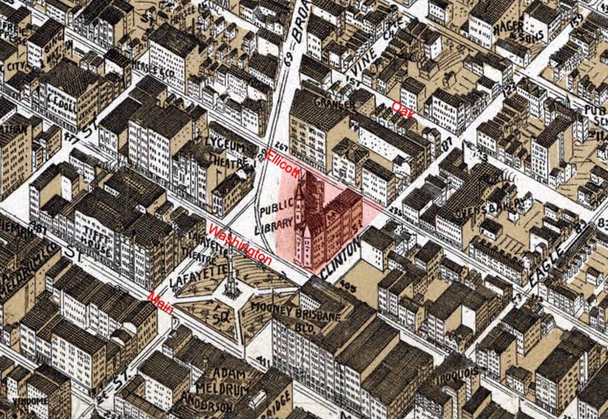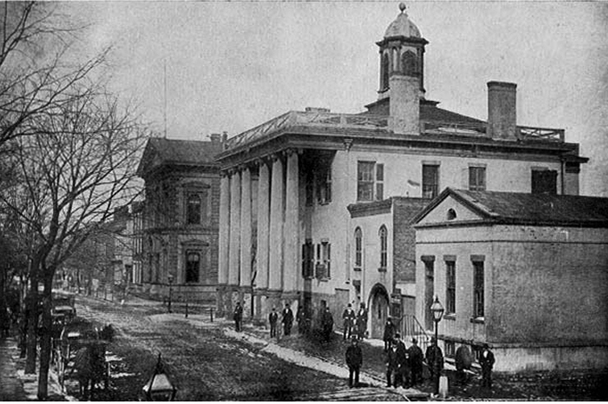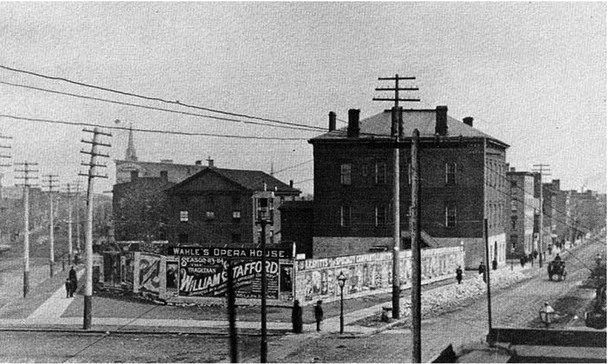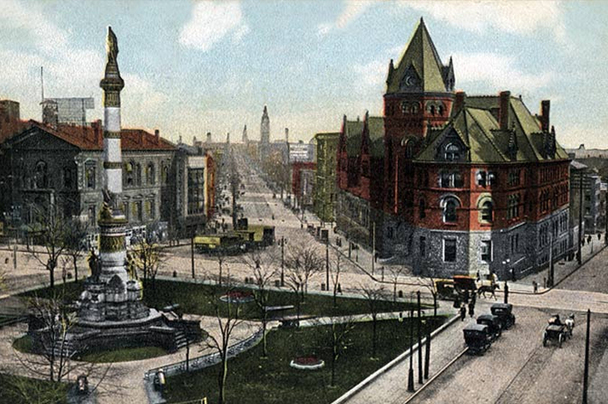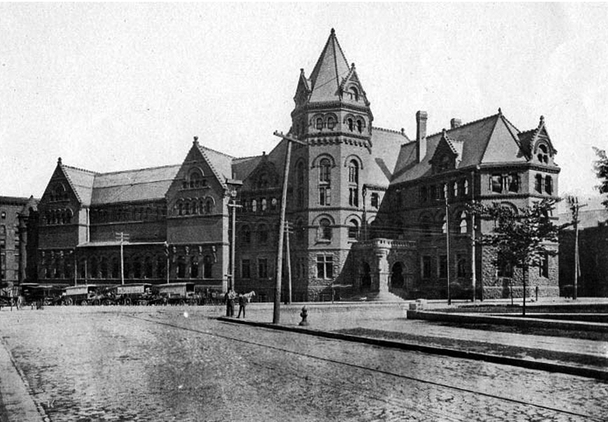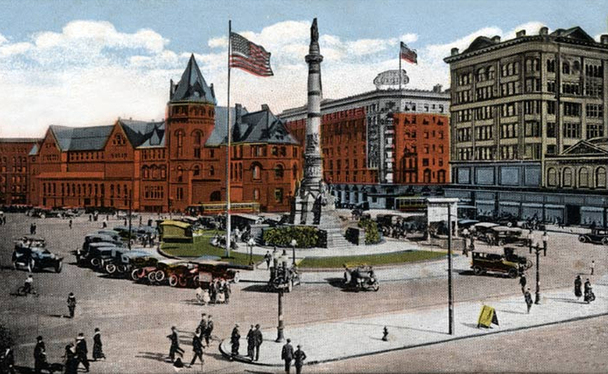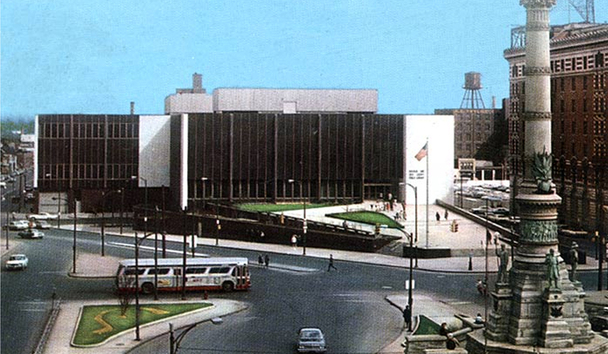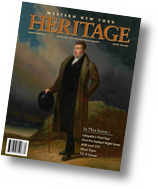The block bounded by Ellicott, Broadway, Clinton, and Oak Streets has a long history of important civic buildings. Although the map below from 1902 shows the Buffalo Public Library occupying this block, the photos below show the block's previous history.
View of the second Court House in Buffalo, facing Washington Street. From right is the Surrogate Building, the Eagle Hose Company No. 2. and the columned Court House. Note its position by comparing its location below with respect to the Lyceum Theater, two-story brick and stone building above at left. The Court House was constructed in 1816 and demolished, along with the other buildings on this block in 1876.
Looking down Broadway after the Buffalo Public Library was completed in 1887. The Lyceum Theater is at left, across Broadway.
The "Buffalo Library" was the result of decades of effort on the part of local citizens to privately create a library. The proponents had moved the library from one leased location to another and had examined various locations for a building. Finally, in 1883, the Grosvenor Library organization, the Young Men's Association, Fine Arts Academy, Historical Society, and Society for Natural Sciences joined forces and determined to build a library on land occupied by the abandoned county buildings on the trapezoidal plot delineated above. In the end, the Grosvenor Library withdrew and the rest of the committee proceeded to raise $175,000 (Young Men's Association) and $117,000 from private subscriptions. The design was awarded to C.L.W. Eidlitz architects; construction began in 1885 and $225,000 later, the doors opened to the public in January 1887. ($4,618,000 in 2005 dollars).
Local author George Kunz recalled his days as a patron of the Buffalo Library, admitting that it was "drafty, rambling, illogical" but nonetheless having charm. It leaked, was hot in summer and cold in winter, and the wooden floors creaked. When the Broadway streetcar rounded the bend on Washington Street, the huge windows in the reading room trembled and the floor shook until it passed. People waiting for the streetcar would huddle in the vaulted foyer when the weather was bad. In 2006, people waiting for the Ellicott Street bus will huddle inside the vestibule of the current library's entrance in bad weather.
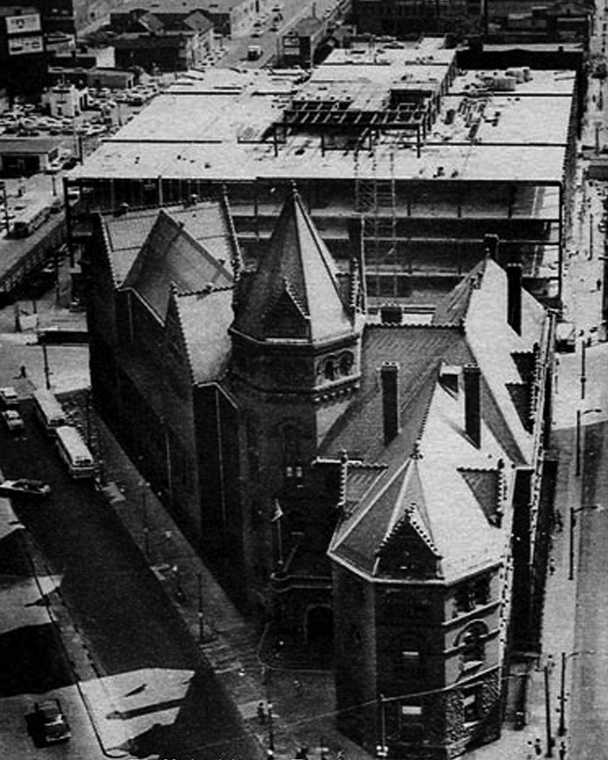
1961 photo of the new library section under construction on the block behind the Buffalo & Erie County Public Library building. The new library would span Ellicott Street and extend continuously to Oak Street.
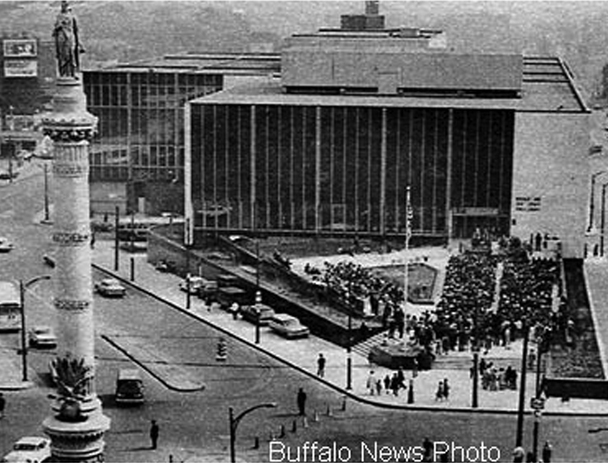
Once the east portion of the library was enclosed in 1963, the books and materials were moved from the old library, after which the brick building was demolished. The remainder of the new library was completed and the new library dedicated on October 17, 1964; photo above is from that date.
The current Central Library of the Buffalo & Erie County Library system was designed by J.W. Kideney & Associates, Paul Hyde Horbach and Elon B. Clark. The construction costs to Erie County were $10,000,000 ($60,355,953 in 2005 dollars).
Below is the editorial published by the Buffalo Evening News upon the dedication, October 17, 1964.
More Than A Building
The new central library dedicated today can be hailed from many viewpoints - as an instrument of better public service, as a contribution to downtown rebirth, as a practical encouragement to all who hold bright dreams of civic progress. In its beauty, the new building is all these things, and much more besides.
But more important than any building as a material entity is the spirit and philosophy which animates it. And no one can mistake the beliefs and aspirations that underlie out investments in free public libraries. They bespeak our dedication to freedom to read and the pursuit of truth and enlightenment. They enshrine our commitment to that sense of free interplay of ideas which is basic to our national ideals and the workings of our national institutions.
Thus more than a $10 million edifice is dedicated today: a democratic faith is affirmed as well.
Let us therefore always cherish the purposes this and sister institutions serve - and let us bolster these functions by doing what is necessary to improve salary schedules as a means of ensuring a proper supply of capable librarians to staff them.
